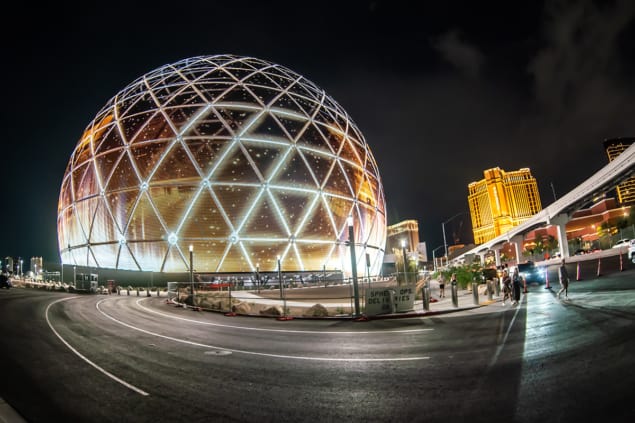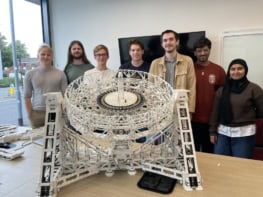Sidney Perkowitz explains what Isaac Newton has to do with a huge, glitzy entertainment dome in Las Vegas

Spheres, globes or orbs: call them what you like, they have always been part of physics even in its early days as “natural science”. The symmetric perfection of a sphere made it the obvious – though wrong – choice for Aristotle’s vision of the cosmos, which saw celestial bodies travel in circular orbits around the Earth carried by nested, rotating crystalline globes.
Later, we learned that because a sphere has the smallest ratio of surface area to volume among standard shapes, a water drop adopts this shape as its lowest energy state. More recently, metrologists have used a polished 1 kg silicon sphere that has had its volume hyper-accurately measured to precisely yield Avogadro’s number.
The properties of curved bodies have also been used to display physics and technology to the public. The 1964 New York World’s Fair featured the Ovoid Theater, a 27 m-high football-shaped venue that housed 500 visitors at a time to view presentations about the future of computers. In 2010 CERN opened its Universe of Particles exhibition in a spherical structure also 27 m tall.
These manifestations of roundness fade away compared to the Sphere, which opened in September 2023 in Las Vegas. With a diameter of 150 m, it is said to be the world’s largest spherical structure. Designed by the architects Populus and funded by a firm specializing in large entertainment venues, it holds more than 17,000 spectators and relies on lots of physical ideas.
The exterior of the Sphere glows with light and colour from 54,000 m2 of programmable light-emitting diodes (LEDs) that display images ranging from fireworks and an undersea scene to adverts of upcoming dome events. Inside, another 15,000 m2 of LEDs form a 270o wrap-around screen. The first custom-made film it showed, Postcard from Earth, tells the story of life on our planet before humanity leaves for distant exoworlds.
Other ways the Sphere depends on physics and mathematics are described on its website. It notes the importance of π for determining the properties of a sphere and shows the maths behind the Sphere’s geodesic structure, made of triangular elements and popularized by the American designer Buckminster Fuller.
The Sphere is a modern realization of an old idea for an 18th-century monument to Isaac Newton
The website tells us of the wave analysis used to project sound from thousands of speakers and of the fluid-dynamics theory behind the wind and atmospheric effects that accompany film showings. Visitors can also learn about the optical analysis needed to display high-resolution images on large curved surfaces.
The Sphere is a modern realization of an old idea for an 18th-century monument to perhaps the greatest physicist of all time – Isaac Newton – whose analytical approach was influential even beyond physics. In 1784, long after Newton’s death, the visionary French architect Etienne-Louis Boullée called him “Sublime spirit! Vast and profound genius! Divine being!” and designed a stupendous structure to honour him.
The design, which Boullée rendered in beautifully shaded drawings, was to be a hollow sphere some 150 m in diameter – by coincidence exactly the same as the Las Vegas Sphere. Embedded in a massive base, it would be circled by rows of huge cypress trees, which represent mourning. Inside, at its base, Boullée envisaged the sphere holding a sarcophagus for Newton.

Visitors would reach the sarcophagus through a tunnel, and from there gaze up at the vast empty volume above. Empty, but not utterly dark. The sphere was to be pierced with openings representing various celestial bodies and through which daylight would pour. At night, according to Boullée’s drawings, a central globular light source some 30 m across would fill the sphere with a brilliant glow.
Boullée’s design was truly only a vision. It could not be built then, nor was there an artificial light source that could fill the imagined structure. Newton, who had been buried at Westminster Abbey in London, remained at his resting place, where his grave – along with a white-and-grey marble monument to him – can still be found.

Memorializing the great: how to honour scientists who’ve died
But Boullée’s construction shares with the Las Vegas Sphere its impressive size and inventive use of light, however generated. By simulating the night sky during the day, Boullée wanted to symbolize Newton’s exploration of the cosmos. In filling the sphere with light in the dark hours, Boullée wished to remind us of Newton’s seminal studies of light.
Will the Las Vegas Sphere ever explicitly celebrate the wonders of nature, science and physics – say, as a kind of planetarium – or honour a scientist? Having cost an eye-watering $2.3bn to build, the Sphere must first reach commercial success. Only then will we perhaps one day see images of Newton and other scientific greats surprisingly but justifiably towering over the colour and action of Las Vegas.



